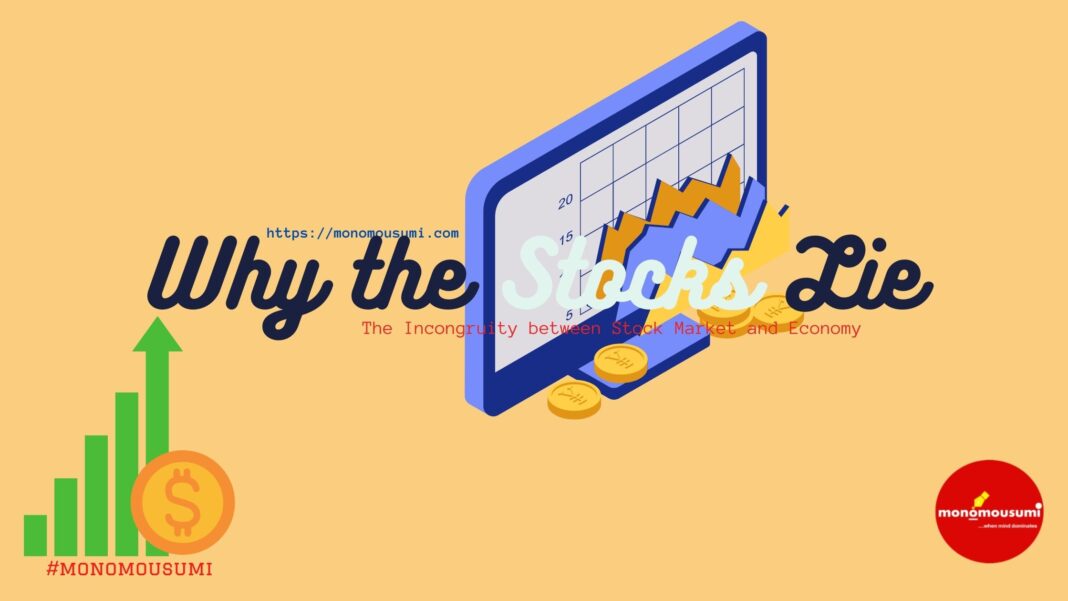The Irrational Relationship Between Indian Stock Markets and Economy
When common economic knowledge suggests that the stock markets should suggest the general performance of the country’s economy, the Indian Stock Markets seem to have greatly differed from this notion. The backbone of the stock markets—the stock prices should reflect the investor’s expectations about future corporate performances, which in turn depend on the economic conditions of the nation. When India experienced the strict lockdowns to tackle the COVID-19 problem, businesses, corporates, factories and shops had to bear consequences, which caused the GPD to shrink to negative points. However, the stock markets apparently emerged to have a mind of its own. It was one of the best performing market in the world in June, 2020, when the BSE Sensex rose to almost 8 percent. This queer phenomenon may seem like a fairy tale being played out, but is surprisingly governed by a lot of factors.
Why this Cacophony?
The evaluations of the stock market are in disagreement with the macroeconomic variables which define the general economic conditions. While the macroeconomics predictions are extremely bearish, the stock markets seem to portray a raging bull. This dissonance can be attributed to a multitude of complex socio-economic factors, the accumulated consequences of which resulted in such a phenomenon.
- Optimistic Outlook of the Future
Stock markets run on predictions for the future. If the future is bleak, the market becomes bearish, and if there is positive news for the future, the market becomes bullish. With the current economic conditions, the investors are surprisingly optimistic for the future. As market trends are always forward-looking, investors already looking towards a fast recovery. The belief that commercial operations will eventually become normal after the pandemic recedes, has actually encouraged a number of investors to buy stocks which has a significantly higher chance of recovery. This has caused a significant buying pressure, and in turn increased the stock prices.
- Intrinsic Make-up of the Stock Market Indices
Another major factor is the giant companies the make up the indices operate under different circumstances when compared to the nation’s small businesses, office workers and the general public. A significant portion of their revenue come from foreign investments. This also enables them to harness more capital and resources to withstand the economic crisis. In fact, market indices like Sensex and Nifty are designed to measure the performance of only the top 30 and 50 companies respectively.
- Limited number of Investors as compared to the population
The majority of Indians avoid investments in the stock markets. Only a meagre 18 million out of a total of 1.8 billion people in India are actually investors in the stock market. This causes a reduction of sample size when statistical techniques are used to evaluate the performance of the stock market and the general economy. The investor’s data are insufficient to adequately describe the economic conditions of the general public. Furthermore, most investors are from the educated and economically stronger sections of the society. This does not take into account the vast majority of poorer people in the country.
- Exposure to Global Markets
Way back in December, 1991, when liberalization of economy began, and allowed foreign investments in India, the stock markets came under the influence of foreign markets. In the present scenario, foreign investments, news, global economic policies are all essential factors that determine the stock market prices. Revenues from the foreign markets are also increasing each year. However, the macroeconomic analysis is primarily domestic and focuses on the economic conditions of the country. This is also a significant reason why the stock market growth seems to have divorced the economic conditions.
- Supply and Demand
The push and pull mechanics of demand and supply on the stock prices can never be ruled out. The COVID-19 pandemic has created a skewed market. For example, biomedical and pharmaceutical companies have experience growth in their businesses however construction enterprises and airlines have incurred heavy losses. Moreover, companies suffering from losses has either laid-off their employees or reduced their numbers. This has caused significant unemployment and loss of income. As a ripple effect, significant changes in the market indices occurred which has further distorted it from the economic realities of the country.
Is There Any Possible Solutions for this Incongruity
According to New York Times, economists who have conducted long term research work on the performance of stock market has concluded that there is comparatively very little evidence that stock market performance actually portray the economic growth. The linkage is weaker than expected. Moreover, the notion that stock markets reflect economic conditions is primarily based on correlation, not causality. The reasons are scientifically thought out hypothesizes which gets fulfilled under certain conditions only. The relationship is empirical in nature, and is only based on observations.
So, as such there is no real solutions as to how it can be rectified. Government regulations and policies can only do very little in this regard. Rather than treating it as an unnatural occurrence, it will be better to treat it as an organic occurrence, which can happen under the right circumstances. Stock markets do have a mind of its own, one which act independently sometimes when the factors favorably aligned.
During the earlier decades of the stock market, it was easier and simpler to link the performance of large companies to the economic health of the nation, partly because a large section of the middle class was employed by them. With the rise of numerous new companies, ease of doing business and more lenient government policies, that link has become obsolete now. The incongruity of the stock markets and the economy is not a by-product of recent predicaments but a gradual change in the economic and business landscape in India.
By Attiso Bhowmick, Karnataka, India










